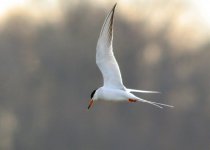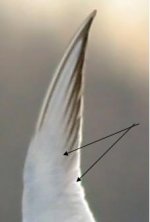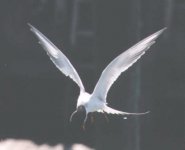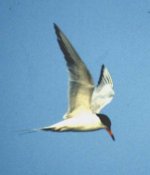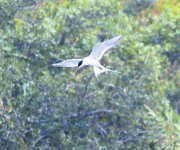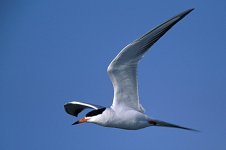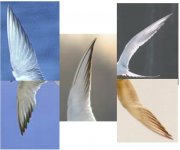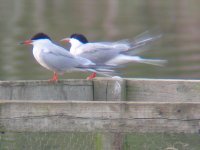-
Welcome to BirdForum, the internet's largest birding community with thousands of members from all over the world. The forums are dedicated to wild birds, birding, binoculars and equipment and all that goes with it.
Please register for an account to take part in the discussions in the forum, post your pictures in the gallery and more.
You are using an out of date browser. It may not display this or other websites correctly.
You should upgrade or use an alternative browser.
You should upgrade or use an alternative browser.
Common Tern? (1 Viewer)
- Thread starter cal
- Start date
More options
Who Replied?Jane Turner
Well-known member
Its a great picture to say its not an Arctic tern.... see the dark tip to the bill, but more importantly the underwing pattern. Arctic would have narrower neater black-edges and showtransluscent feathers. Common Terns show a really distinctive feature the inner 4 primaries are transluscent and form a panel.
I need to look into what a Forsters tern might look like in summer plumage. Hopefully someone will beat me to it!
I need to look into what a Forsters tern might look like in summer plumage. Hopefully someone will beat me to it!
Attachments
Last edited:

Hi Cal,
I think this is quite difficult but I reckon it probably is a Common Tern. The black trailing edge to the primaries (at the wingtip) is right for Common (I think Forster's would show a less contrasting grey trailing edge - but I've not seen too many so might be wrong). Also, the red on the bill looks to me to be the right shade of red for Common, although the bill maybe looks a bit thick for one. But I'll stick with Common Tern.
I think this is quite difficult but I reckon it probably is a Common Tern. The black trailing edge to the primaries (at the wingtip) is right for Common (I think Forster's would show a less contrasting grey trailing edge - but I've not seen too many so might be wrong). Also, the red on the bill looks to me to be the right shade of red for Common, although the bill maybe looks a bit thick for one. But I'll stick with Common Tern.
Jane Turner
Well-known member
Not got info on the underwing of Forstes to hand..... if that's not a photographic effect, the upperwing that you can see looks a bit clean for Common. Will do some homework!
Michael Frankis
conehead
My guess, not 100% certain though, is for Forster's Tern: (a) the large bill with over a third black at the tip (only the end quarter or so black on Common, and not quite such a heavy bill), (b) the very pure white underparts (the North American race of Common Tern has a greyish wash to the belly), and (c) I think the underwing pattern is probably OK for Forster's
Michael
Michael
Jane Turner
Well-known member
Seems strange that Sibley doesn't spell out the Uw-pattern.. Collins doesn't comment on it but shows a pattern like Common and grey central TFs... which this pic is carefully taken to avoid showing. I've only seen winter plumage Forsters and to be honest I didn't look at their underwings.

Here's some Forster's pictures I found. I don't think any of them really show the same contrast between the blackish tips and edges to the primaries and the whitish inners as is found in Cal's bird but I guess Forster's may be more variable than this. Also I don't think the bill is as thick looking as on some of these Forster's (and I think the red isn't orangey enough either). The black is more extensive on the bill than usual but maybe it retains a bit more of the black from winter plumage, which would be reasonable if this is a spring bird. I must admit, if I saw a bird looking like Cal's over here, I wouldn't be getting too excited about it (nice looking though it is). I'd like to hear other opinions though.
Attachments
Jane Turner
Well-known member
Oh dear I was going the other way... I've looked again and I only get two of the inner primaries untipped on Cal's bird! Common's should have a bigger panel... I've had a look and found the colour and with of the tips to vary but the number of inner pps in the panel to be more constant.
common - cal - forter's
common - cal - forter's
Attachments

By untipped do you mean lacking in a dark tip Jane? If so, in the four pictures of Forster's I put on the number seems quite variable. That bill on Cal's bird also looks increasingly slim and delicate to me, when I compare it to Forster's. See the fourth bird in my sequence.

A couple of questions on the underparts. Firstly, it looks to me as if it has a more greyish collar. This might well be a photographic effect, so I don't know how significant it is. Secondly, would an early season Common Tern necessarily be extensively grey underneath bearing in mind that it would be much whiter in winter plumage.
I'm also struggling to see Godwit's point about the white on the lores. I would say that the bottom edge of the crown runs fairly straight from the bill to the forecrown and that below this is a parallel sided white loral patch tapering to a point. It's breadth is relative but it doesn't look all that broad to me.
With the forked tail, it looks to have quite long streamers but then I think in spring these are going to be fresh and relatively long on any species. From the picture I find it hard to accurately assess how deeply forked the tail is.
I'm also struggling to see Godwit's point about the white on the lores. I would say that the bottom edge of the crown runs fairly straight from the bill to the forecrown and that below this is a parallel sided white loral patch tapering to a point. It's breadth is relative but it doesn't look all that broad to me.
With the forked tail, it looks to have quite long streamers but then I think in spring these are going to be fresh and relatively long on any species. From the picture I find it hard to accurately assess how deeply forked the tail is.
Taco
Well-known member
Not trying to sound like I know my terns very well, because I sure don't...but it seems like the Forsters tern has a orange bill, while the Common has more of a deep red bill. I could be wrong on this, because the times I see common and forsters at the same time here in michigan, is usually when they are in nonbreeding plumage. My guess on this bird is that it is a Common Tern, and by the way very nice picture Cal.
Taco
Taco
alan_rymer
Well-known member

Just for beak comparison!.Michael Frankis said:My guess, not 100% certain though, is for Forster's Tern: (a) the large bill with over a third black at the tip (only the end quarter or so black on Common, and not quite such a heavy bill), (b) the very pure white underparts (the North American race of Common Tern has a greyish wash to the belly), and (c) I think the underwing pattern is probably OK for Forster's
Michael
I do not know anything about Terns, especially the American varient of the Common Tern. Here are a pair of Common photographed on the 26th April. The Dark tip on the left bird is nearly half, the right bird has a weird bill. Its curved and very heavy although the tip is about a quarter!.
Attachments
Jane Turner
Well-known member
Well I just don't know.... it would be so easy with an upperwing shot!

I was wondering why not many Americans had responded on this - but then maybe they just realise it's not worth bothering to try and ID them from underneath!
Jane Turner
Well-known member
Still feel it ought to be possible...
Hmm. All that Malling, Olsen and Larsson have to say about Forster's underwing is: "The underwing is similar to Common Tern, but the dark rear edge to the hand is paler, rather like that of Sandwich Tern in colour: the hand is framed by black outer webs to the outer primaries."
Katy Penland
Well-known member
Sorry, sorry, had to go to the shops for some wine before the weekending flatlanders bought it all!Fifebirder said:I was wondering why not many Americans had responded on this - but then maybe they just realise it's not worth bothering to try and ID them from underneath!
Not that I've seen that many Commons, but this looks like a typical Forster's to me (west coast--never seen 'em east of the Rockies). Altogether a much brighter white bird than Common, and the bill can sometimes be more reddish than orange. As Michael pointed out, the Commons I've seen here are overall more dingy colored, and the upper wing darker than Forster's.
Nice capture!
Last edited:
Similar threads
- Replies
- 12
- Views
- 515
Users who are viewing this thread
Total: 2 (members: 0, guests: 2)




